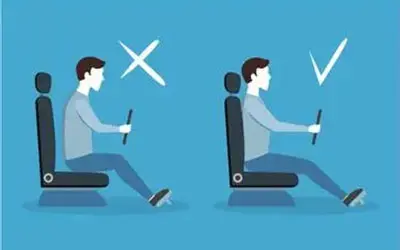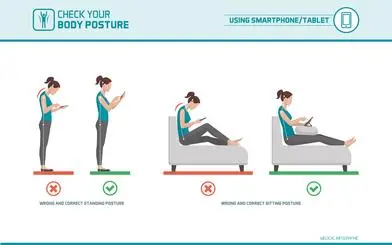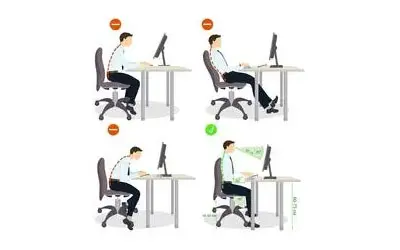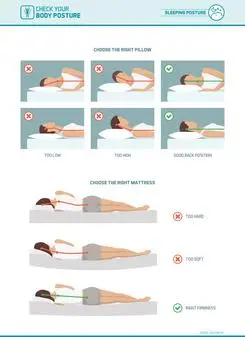Improve Posture and Reduce Pain
Consulting a healthcare provider is a good idea before attempting to improve posture issues. This pamphlet is designed for general advice and is not meant to treat specific postural conditions.
So, you are caught in the grind at a stressful job, with long hours sitting on the commute, at the desk, and in the commute again on the way home. Now that you think about it, you may be sitting all day long and rarely give yourself a break to change positions. As it turns out, humans are not meant to sit for prolonged periods without a change in posture. But if you are stuck in this scenario, there are some easy things that you can do to minimize your back and neck pain.


On the Road
Let’s start first by looking at your position in the commute. First, most car seats are not ergonomically designed, and those that claim to be so may not fit your body type perfectly. The idea here is to provide yourself with enough lower back support so that the natural curves of the spine are maintained. Frequently, car seats only preserve a minimal lumbar curvature, and so driving in this position for upwards of an hour can become uncomfortable. IDEA: Place a small pillow behind the upper part of your lower back to maintain the curvature better. Small pillows are easily attainable at retail stores for around $5-$10.
At Work
So, you sit down in your chair to start another day. Here are some easy tips to help improve posture and reduce pain:
Sit up with your head over the shoulders and the shoulders over the hips. Do not slouch if you can help it. Use a pillow at the upper part of the lower back to help.
Use your armrests, especially if they adjust. They should fit under the elbows and lift the arms slightly.
Keep your monitor and work at eye level and in front of you. Turning the head slightly can greatly increase pain over the workday.
Lower your seat so that your feet rest flat on the floor. Knees and hips should be at 90°. If you are too short and your feet cannot rest flat, get a small stool or a footrest.
If you must type and talk on the phone, USE A HEADSET. It makes a world of difference and is worth the expense.
GET UP!!! About every 45 minutes or so, get up and stretch gently, or take a short walk if you can.


If you need to slouch for a while, do so, and then pull yourself back into good posture. No one says that you have to sit straight all the time.
Keep your keyboard and mouse close to you, and even with the elbows.
Stand Straight!
So, someone tells you that your back and neck pain may be related to your posture. But what does good posture mean? How do you correct your posture once it is bad? Correct posture is a simple matter of mechanics. The head, neck, and back all have to align properly to work efficiently. If the spine is in proper alignment, then the muscles that support them do not have to work as hard, and your pain can be reduced. To find a proper posture, simply stand up with your heels, buttocks, shoulder blades, and head against a wall. The shoulders should be relaxed, and the chin tucked, as in the picture.
Yes, believe it or not, this is a good posture. The weight of the head sits on the shoulders; the shoulders sit over the hips, hips over the knees, knees over the ankles. If you can draw a straight line through each body part, then your body is in proper alignment. Now, some people may not be able to get into this position easily - do not force it. Posture is something that must be corrected slowly and with care.

In Bed
Ok- so you are exhausted and finally get home. After a healthy and nutritious dinner (right?), you collapse into bed.
But you also have to pay attention here as well. After all, you are supposed to be sleeping a good 8 hours a night.
But even if you are not, keep some of these things in mind to improve posture problems while sleeping.
Your pillow should keep your head in alignment and provide support. If you sleep on your side, it should take up the space between your shoulder and the side of your head. The neck should not be tilted one way or the other. If you sleep on your back, it should tilt the head upwards slightly, but not aggressively.
Flip your mattress every 6 weeks to keep the springs fresh (if your mattress has metal springs, that is). The first time you do this, flip it over and turn it so that the head becomes the foot of the bed. The next time, just rotate the head to the foot and do not flip. This will ensure the maximal spring to the bed. Alternate between these two methods.
If your bed is sagging, consider replacing it. Hey, you spend a lot of time on your mattress, so it's worth the investment for a good one.
If you need to use pillows beneath or between your legs, do so.
Relax a bit about your sleeping posture. Other than your choice of mattress and pillows, you really cannot control what your body does.
If you need further clarification about postural and ergonomic stressors, call (202) 257-1363, and we'll answer your questions.
The Center for Neuromuscular and Massage Rehabilitation is a top provider of physical therapy, chiropractic, and massage therapy services in downtown Washington, DC.
We are prepared to handle a wide variety of clients, from athletes with serious injuries to chronic pain and Fibromyalgia to those with longstanding alignment issues. At CNMR, we treat people one-on-one and offer a sincere, personal, and directed approach to healing your body.
